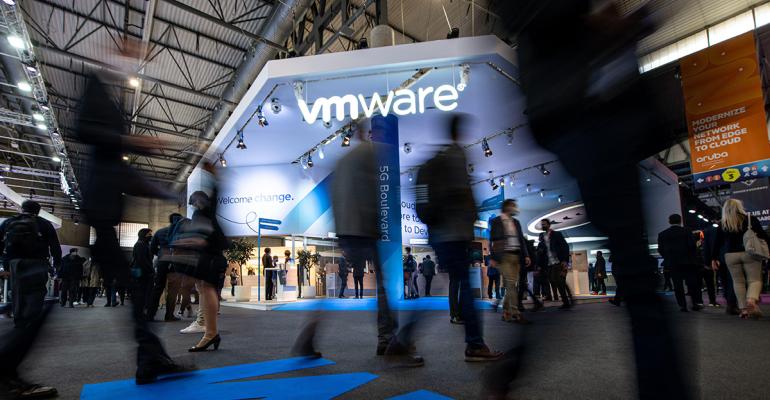In the weeks since Broadcom closed its acquisition of VMware, there has been a considerable amount of controversy surrounding the wholesale changes taking place across the entire company – from changes in licensing and its channel program to ending its partner program. All this is happening under less-than-ideal communications, leading to misunderstanding and chaos.
For example, a recent blog post by VMware on a “new licensing policy” impacting several products – most notably vSphere and vSAN virtualization software, along with Site Recovery Manager, vCloud Suite, and Aria Suite – has been misinterpreted as the ending of the availability of these products. The products are not going away, they are just no longer going to be sold individually but rather as bundles.
The miscommunication has led to Broadcom scrambling to assure customers that it is not jettisoning these products, which are used for managing critical data center resources and IT systems.
Product Assurances
Matt Kimball, vice president and principal analyst for data center compute storage at Moor Insights & Strategy, chides Broadcom for its less-than-effective communications.
“What I think could have been done better is there could have been a better job messaging and telling that story,” he told Data Center Knowledge. “There’s similar angst around the channel and what they’re doing in general. My impression is that the company is trying to make up for that lack of communication upfront with these assurances.”
Kimball said that, in speaking with Broadcom, they’re going to change the licensing models and the way they bundle the solutions. “They’re going to make sure that there’s availability for every customer,” he said.
Even with the confusion aside, forcing customers to buy bundles of software that they may not need is going to put a burden on them, said Rony Moyal, vice president of Americas at Virtuozzo, a virtualization software firm that serves the cloud service provider (CSP) and managed service provider (MSP) markets.
Moyal sees far greater disruption for the MSP market than for the end-users because the MSPs are the ones who have to deal with the licensing and deployment of the software.
“It’s most of the middle tier [who will feel the changes], of which the MSP and the system integrators not only have to learn new technology now but also need to understand how this new technology is working with the payloads of the customer – and make sure that there's no disruption for them,” he said.
Mid-Market Challenges
Steve Tuck, co-founder and CEO of cloud server vendor Oxide Computer, echoes this sentiment, saying that if Broadcom were to favor enterprise customers, who are less likely to feel the impact of the changes, that could have a negative impact on the mid-market.
“Less choice is always bad, worse for our customer,” Tuck told Data Center Knowledge. “I think that the large enterprises are using a lot of products, so the bundling may not have quite as significant of an impact. For the mid-market folks, even probably small enterprise companies, this poses a real challenge because if you've got to pay for a bundle where there’s nothing else that you are using, your price is going up – and going up quite a bit.”
But Kimball feels the streamlining of product offerings into bundles was a necessary evil. “If you’re going to go after the cloud and data center market, it helps to make a simpler and more consumable message and product licensing structure,” he said. “I think that’s a lot of what we’re seeing here. There’s a refactoring of how the company has gone about offering IT solutions. And that’s going to rub some companies or some people the wrong way.”
Tuck said the bundling and license changes were unexpected and, in most cases, no planning was made for them. “It was not in budget planning for 2024 for pricing increases in data center infrastructure. If anything, companies are trying to figure out how to do more with less,” he said.
Who’s In, Who’s Out?
Oxide has talked with staff at VMware that work with service providers and, with all the changes going on, the partner community has been trying to figure out who’s in the partner club and who’s out.
“Those that are out can be really materially impacted because they’ve got to navigate these customer relationships without being able to be a good service provider for VMware,” he said.
Last year, Forrester Research said it expected up to 20% of VMware customers to defect to other virtualization platforms, or at least consider it. Tuck said he believes many organizations are exploring alternatives to better understand what is out there and how they could potentially be used as an alternate solution.
“We have not seen or heard of a single entity that is not reevaluating things, and there are definitely plenty of companies that will be moving,” he said.
This is going to be a lengthy process, and users are not going to just flip the switch and migrate to a new platform overnight. They are, however, very much scanning their infrastructure and building the pathways for a potential migration, over the course of months or even years, Tuck added.
And as it turns out, some organizations are already betting that some customers aren’t going to wait. Sensing an opportunity, Scale Computing has launched a so-called “rip and replace” program for VMware customers. That probably won’t be the last vendor to do so, either.
“I would suggest to anybody that is looking into [new] technology: Look at something that is solid, has all the features in it – meaning you don't need to buy the core and then and add a lot of functionality for extra premium, but rather something that is ready out of the box with all the features – and has easy-to-understand billing,” said Virtuozzo’s Moyal.





